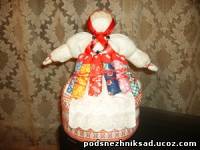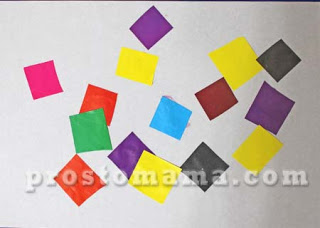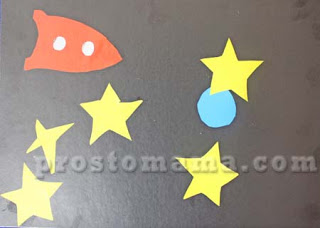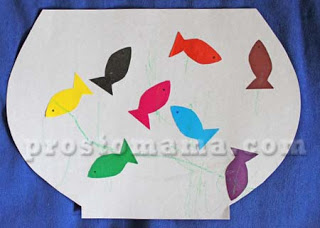No matter how your kid grows up - calm and quiet, or quick-tempered restless - there is an activity that can work wonders. This is an application. During the lesson that can be carried out by any mother, the child’s eyes light up: he sees a real masterpiece from under his fingers. Believe me, children really like this pastime.
Application - is it ..?
Application is a type of creative activity, during which various shapes are cut out and glued onto the base (usually paper or cardboard).
The most common material for the application is colored paper, cardboard and fabric. However, for this purpose you can successfully use tree bark, dried leaves, needles, straw, twigs, feathers, grass, moss, egg shells, yarn, cotton wool, shells and pebbles, beads, plastic bottle caps and many different materials. .
Application gives children ...
Application - one of the favorite types of children's artistic activities. Being engaged in appliqué, your baby will be busy with business. The process itself and its result will bring the child a lot of pleasure. Children are pleased with the bright color of the paper, the successful rhythmic arrangement of the figures, and the cutting and sticking technique is of great interest to them. Such activities significantly bring parents together with the child.
Paper application for children can be a very interesting and educational activity. The baby develops and improves fine motor skills, which in the best way affects the mental development of the child. During the lesson, the child develops artistic imagination and aesthetic taste, as well as design thinking. Sixth, apprenticeships develop abstract and object thinking, and even speech.
The application is closely related to sensory perception and cognitive activity, which also has a huge impact on the development of children's mental and creative abilities. The development of sensory perception is facilitated by paper processing operations: bending, cutting, tearing and tearing, gluing.
Getting started…
Application is one of the most accessible and understandable types of children's creativity. In fact, the application is not difficult to do, you can prepare for a few minutes or in the process of training with the child. We recommend that you pick up colored cardboard or paper, scissors, paste or PVA glue. Cut various shapes and images: circles, ovals, leaves of different shapes, apples, pears, cars, animals, etc.
Once the material is ready, you can start classes. But an indispensable condition - you and your child should be in a good mood. To begin with, suggest that the child stretch their palms and fingers. Here you can help finger games or the following exercises.
- "Funny spray" - shaking and relaxing the hands in a different rhythm, imitating the splashing of water droplets.
- "Fingers tapping" - percussion with your fingers all at once or alternately on any hard surface.
- "Get to know the subject" - the child is asked to use his fingers to “guess” objects, toys with pronounced details.
- "Fingers greet" - tip thumb The right hand alternately touches the tips of the index, middle, nameless, little finger.
- "A Hasty Bug" - fingers of hands quickly move on the table surface. These exercises develop small muscles fingers, create a good mood.
If your desire is not shared by your baby, do not worry. And, each time consider the mood and desire of the child. At first, the lessons of the application should not be longer than 15 minutes.
Caution!
Probably, every mother intuitively understands what is possible and what should not be allowed during classes with children. Nevertheless, it is useful to recall the following:
- prepare the workplace for the child: it should be clean, comfortable;
- during work, do not allow the child to take glue in the mouth or to smear it anywhere;
- make sure that the baby does not play with scissors, but uses them for their intended purpose (he must understand that this is not a toy, because if he doesn’t get hurt this time, he may do so in your absence).
Try an appliqué at home with your child:
There are so many types of applications for children that it is difficult to tell about all in one article. However, we list
main ones:
☺ From napkins: draw the outline of the picture on a piece of paper or cardboard; finely tear the napkin; roll up lumps of napkins together; Pour the paste or glue of PVA in a shallow container. Let the child take the ball from the napkin and dunk it in glue and stick it on the image, trying to stick the ball to the ball. The result is a voluminous and beautiful picture.
☺ Clipping appliqué: in this case, we tear the paper into pieces and make an image out of them.
☺ Surface application: this technique allows you to get a multi-color image. Conceiving the image and consistently create it and applying and pasting parts in layers so that each next part is smaller than the previous one in size.
☺ The volume application of colored paper is a type of crafts with children that does not require training, special tools or possession of any special skills. In order to make a beautiful volumetric application you need scissors, glue, colored paper and a desire to make a beautiful crafts. In children involved volume application increases the level of attention, patience and perseverance, and also develops hand motor skills.
☺ Application of seeds and cereals: in this case, you will need seeds (watermelon or pumpkin), cereal, pencil, cardboard, PVA glue. On the cardboard we make a drawing with a pencil, then we coat the drawing with PVA glue and sprinkle it with groats or seeds. Appliqué croup gives your child a lot of pleasant tactile sensations.
☺ Application can be done using other materials:
bark, needles, straw, feathers, twigs, grass, moss, matches, yarn, cotton wool, plasticine, shells, pebbles, dry berries, beads and rhinestones, egg shells, foil.
Unleash your imagination and you will have a lot of ideas for applications, wonderful crafts and a lot of positive emotions you and your
Spend your leisure time with your child.
Imagine and create!
Creative success to you!
How does the application develop the baby?
Application - one of the most favorite activities of children. Children like to cut something out of paper or fabric, glue, paint and eventually get a creation made with their own hands. How much joy in childhood brought us making cards for the holidays for parents. You can do the application with children of any age. Any creative activity, in particular, application, is of great importance for the mental development of children, expanding the stock of knowledge on the basis of ideas about the various forms and spatial position of objects of the surrounding world, various values, variety of shades of colors. In the manufacture of an appliqué product, it is important to pay attention to the variability of shapes and colors (ripe - not ripe berries, plants at different times of the year), different spatial positions of objects and parts (the bird sits, flies, pecks grains; the fish swims in different directions, etc. .).
Catching the app, children will learn different materials (paper, paints, clay, crayons, etc.), get acquainted with their properties, expressive possibilities, acquire skills of working with them. Children also learn experience with some tools. human activities (pencil, brush, scissors). All these actions contribute to mental development children.
To create an application, it is necessary to apply efforts, carry out labor actions, master the skills to sculpt, cut, draw an object of one form or another, and also master the skills of handling scissors, pencil and brush, clay and plasticine. Proper possession of these materials and tools requires a known expenditure of physical strength, labor skills. The mastering of skills and abilities is associated with the development of such strong-willed personality traits as attention, perseverance, endurance. Children are brought up the ability to work, to achieve the desired result.
The most important thing is to ensure safety during the process. Prepare the workplace. Cover the table with oilcloth, lay out all the material so as not to have to be distracted. Put work clothes on your baby. Do not rush to do everything for the child. From the very beginning, teach your child to clean, let him help you prepare the table for the application and clean it after work.
What kind of material can be useful for applications? Yes, whatever. Paper, (color and white, glossy, velvet, "marble", self-adhesive, etc.); plasticine; paints; glue; Scotch; the pencils; beads; old magazines; pieces of cloth; patterns of different subjects; cotton wool; wrappers; candy wrappers from sweets; labels; packaging from purchases; disposable paper plates; pieces of cloth, leather, fur; colored yarn, trimming yarn, buttons (neatly sewn to the cardboard mom); cereals, pasta, vermicelli; foil, adhesive tape, polyethylene trim; dry branches, needles, leaves, herbs, flowers, straws, orange peels; sawdust from pencils.
What to prepare for work.
Scissors. Suitable in size to the handle of the child, light, with blunt ends, not tight, moderately sharp.
The base is sheets of paper or cardboard (colored or white). Any size and format, thickness or texture, a wide variety of configurations. For example, you can use the same cardboard boxes. In addition, you can make bulk crafts from colored paper, for which the base is not required.
Glue: - with a brush. With 3-4 years we have successfully adapted ourselves to making applications with adhesive pencils: children learn to work with them quickly and easily; There is only one drawback - such applications are less durable, after drying, parts can fall off (however, this depends on the quality of the adhesive pencil).
For the first classes, use simple tasks. Take a white sheet of paper. Cut out square, triangle and rectangle from colored paper. Paste these forms, forming a small house with a pipe, you can cut out the sun and clouds and also paste them. On the house you can draw a door, and smoke from the chimney. Believe me, this not difficult job will bring a lot of positive emotions to your baby. Give this picture to your dad or grandmother.
An older child can be given freedom of action, or offer more complex applications, with the use of many options. Make a picture of cereals and pasta. Spread cardboard with glue and sprinkle with cereal and pasta. Then color the product. Thus, you can make a frame for a photo. Imagine with your child.
What does an app give to a child?
Did you know that the application:
Develops artistic imagination and aesthetic taste;
- develops design thinking - from parts to assemble the whole;
- develops motor skills and tactile sensations, especially if in addition to paper other materials are used - cloth, groats, dried flowers, straws;
- helps to learn colors and shapes;
- introduces the concept of "technology" - to get the result, you must perform a sequence of different actions: cut out the parts, grease the paper, sprinkle the cereal, smear the clay?
And how often do you do applications with your child? Surely, less than draw. Just because it is simpler to draw - they took paints, took a brush. ... But you need to prepare for the application in advance - prepare the paper, create a story. ... In fact, it is very easy to make an application. You can prepare for it in a couple of minutes and even during the session.
What is modeling for?
Modeling - A very important activity for the child, which develops creativity, fine motor skills of hands, spatial thinking, the concept of color, the shape of objects. In addition, modeling (and not necessarily from clay) has a beneficial effect on nervous system generally. In general, the benefits of modeling are enormous.
How to start classes in modeling clay?
First, remember that during the modeling sessions you will have to be close to the child, not only as a “supervisor” (so as not to eat clay), but also as a creator (to mold yourself, together with the child).
Secondly, do not overdo it with the complexity of tasks for your baby, do not demand too much from him. Remember that the child only gets acquainted with the properties of clay, studies them and experiments with modeling techniques.
What can a child do in plasticine in two or three years?
Pinch off a piece of clay from a large piece;
· roll a plasticine lump between your palms in straight movements (sausages, sticks);
· roll a plasticine lump between palms in circular movements (ball, apple);
· flatten the lump between your palms (cookies, tortillas);
· make a finger groove in the middle of a flattened lump (bowl, saucer);
· combine two fashioned forms into one object: a wand and a ball (rattle), etc.
Classes with babies from one and a half years are based on these actions. Develop these skills, expand and improve them.
How and what to sculpt from plasticine with a baby
Color selection . Start by choosing the color of plasticine: ask the child to choose, for example, from two colors (you should not offer the whole box of plasticine at once, otherwise the child will simply “run up”). The main thing is that the child is attracted, not repelled, so do not choose yourself for the child - your preferences can vary greatly.
Warm up . Mash plasticine with your hands: let the child knead his little bar, and you let your own. After the "warm-up" you can proceed directly to the modeling.
Basic actions:
Show your child how to knead the clay, pinch a piece of it, make a cake out of it ... In general, follow the basic steps described above. For the first lesson, performing the simplest manipulations will be enough to interest the child.
Pieces
Plucking pieces of clay - one of the favorite activities of kids. Direct this activity in the right direction - stick the pieces on a thick cardboard or just on a sheet of paper. A more sophisticated version of this quest: stick pieces of clay “with meaning”: “decorate” a painted Christmas tree, hang apples on painted apples, etc.
"Sausages" and "balls"
The resulting "sausage" can be rolled into a ring or a snake. And small balls can be crushed with your fingers.
Prints
One of the most exciting activities for kids is to make prints on plasticine. You roll a cake from plasticine, and the kid pokes him with everything that you can (or rather everything that you offer him): a toy fork, a cap from a felt-tip pen, your own finger, a spoon.
Plastering
Suggest that the baby stick a glass or any other container with plasticine, which can then be decorated with beads or any other material - you will get a great vase. For younger children, you can cut out patterns of different figures and stick clay on them.
Plasticine and other materials
In the modeling of plasticine, you can (and should!) Use other materials: peas, beans, buckwheat, macaroni of various shapes and colors, buttons, etc. Roll pellets from plasticine and have your child stick small objects on them (this is very useful for developing fine motor skills in a child's handle). Make sure that all these wonderful items are sent to the clay, and not in the mouth.
PEOPLE DOLL
The doll meant a lot in the life of people — it was fashionable with the help of dolls to educate children, protect their loved ones, guess, pass age initiations, protect their home and attract wealth and happiness to it. The dolls accompanied the person through life, starting from infancy, when the baby was allowed to play doll - cabbage or feeder, as it was variously called in different areas. Such a doll was made from identical square pieces of clean rags and was completely safe for the child. She served him at the same time as a pacifier, toy and amulet.
It should be noted that traditional dolls usually did not draw faces. It was believed that if this was done, then a foreign spirit could move into the doll. And so, without a face, she simply transmitted through herself what the person who made her, a piece of his soul, good wishes, warmth, put into her.
One of the important things in the house was doll mistress.
It was made according to the principle of the post, which got its name as a basis - a tightly rolled up fabric. Column - the hostess was not removed in the chest, she stood in a prominent place and made sure that everything in the house was fine. If something was not right, the husband could express it to the doll in a joking manner, so that the wife could hear. This doll was also a kind of psychological lightning rod in the house, helping not to save restraint, and at the same time not to hurt a loved one, expressing his displeasure to him.
Gave the wedding and special wedding dolls - they were called one-penor lovebirds.
These are male and female pupae, which at first glance seem to be just a couple holding hands. But, if you look closely, you can see that their hand is one made of a solid cloth or wand. Such a hand was considered a symbol of their unity, and the fact that everything from the moment they were married became common. If a couple suddenly got divorced, or left for some reason, then they also separated these dolls.
Over the threshold of the house hung
coastal doll

She was facing the entrance to the house, and it was believed she could protect the house from the evil spirit and the evil eye.
It became the hostess in the house and many-handed ten-pen doll.

Ten-hand doll helped a girl or a young woman (a girl who had recently got married) in the household. Such a doll was often given for a wedding so that a woman could manage everything, and everything went well with her.
Vesnyanka
Doll Charm "Vesnyanka" in Russia made young girls when spring came, and gave these dolls to each other. The doll has a cheerful and perky character. Traditionally, she has bright hair of unusual color.
Vesnyanka - a doll preserved youth and beauty. By giving this doll, you wish the addressee a long youth and attractiveness, optimism and cheerfulness. ![]()
Pupa for luck.

This baby with a large braid easily fits even on a small palm. Well known about dolls for happiness is not very much. Similar pupae were found on the excavations of ancient Rzhev. And they got the name for their long braid - a symbol of female beauty that the groom bought at the wedding, receiving a ransom for the one that he could make happy.
As you can see, traditional dolls are a whole world that is inhabited by very interesting tenants who carry magic and centuries-old wisdom.
My daughter and I started using glue at about 1 year and 4 months. Most of all she liked to put glue on paper and pick it with a finger. Well, for her it was an object for study, something new and unknown. After studying, we just washed the pens together, because everything stuck to them, and Annie did not like it.
How to teach a child to work with glue?
First show with your example how to apply glue to the figure, take it, turn it over, put it on the painting and pat it. As a rule, clap kiddies like the most.
When performing the first applications, give your child the opportunity to play around with glue. Better for this use double sided colored paper or glossy magazines. In this case, you and the child do not have to follow on which side to apply glue. He will do as he likes, enjoying the process.
Cut large parts. Figures will stick to the fingers, they will be difficult to turn. When a child applies glue, help him hold the shape, make sure that he moves his hand parallel to the working surface.
If the baby does not manage to apply glue to the figures, or he simply does not like it, apply PVA glue on the base, and offer the child to arrange the figures as he likes and press them with the fingers or the palm.
Remember that the result is not important for the crumbs. For him, creativity is a process that brings pleasure.
Ideas for applications with kids
1. Abstract applique or simple paintings
Cut different shapes from colored double-sided paper and show how to glue them onto cardboard or landscape sheet.
From different geometric shapes You can create a beautiful abstract picture.

You can beat her by offering to make a “blanket” for your favorite doll, or a car path strewn with colored stones.
So glue will be much more fun and interesting.
If you take colored cardboard as your base, you will get simple pictures:
- Flower meadow (base - green cardboard on which flowers cut from colored paper are glued);
- Starry sky (base - dark blue / black cardboard, figures - big and small stars, planets, rockets).
- Snowfall (base - blue cardboard, figures - white circles, snowflakes)

2
. Application - collage
Cut out pictures from old magazines, newspapers, postcards, boxes of baby food. For the base, take a white cardboard or thick sheet of paper. Show your baby how to apply glue and turn the picture. Together, determine which side to apply glue.
Give the kid the opportunity to stick the pictures the way he wants, you can even one on the other, and then compose a fairy tale for him on the resulting picture. Believe me, your child will be delighted.
By the way, if your child has a good brush, you can use PVA instead of pencil glue. Pour the glue into a small container (you can use bottle caps or a small plate from a set of children's dishes).
3. Application on the workpiece
Instead of a regular sheet of paper, you can offer your child to decorate a pre-prepared base, such as a butterfly.
Cut a butterfly from cardboard or a thick sheet of paper, cut circles, ovals, squares and triangles from two-sided colored paper. Suggest the child to stick them on the butterfly and make its wings bright and beautiful.
Glue can be applied both on the figures and directly on the base. Act as it is more convenient for the child. Anuta likes to smear with glue right on the base, and then put decorations there.
Ideas blanks for applications:
- aquarium - baby will populate it with fish and draw algae;
- a plate on which candy is pasted;
- christmas tree - you can decorate with balls, toys, and even tinsel of threads;
- apple tree - stick yellow, red or green apples to it;
- giraffe, zebra - cut big size, and the baby will stick spots or stripes.
- a hedgehog that bears apples and mushrooms.

4. Finished applications
I buy for Annie the book "Application for kids" (they are A5).
In each book there are 4-5 applications consisting of a black and white contour of a fairy tale hero or animal and color details (3-4 parts). The price of such a book is only 10 rubles.